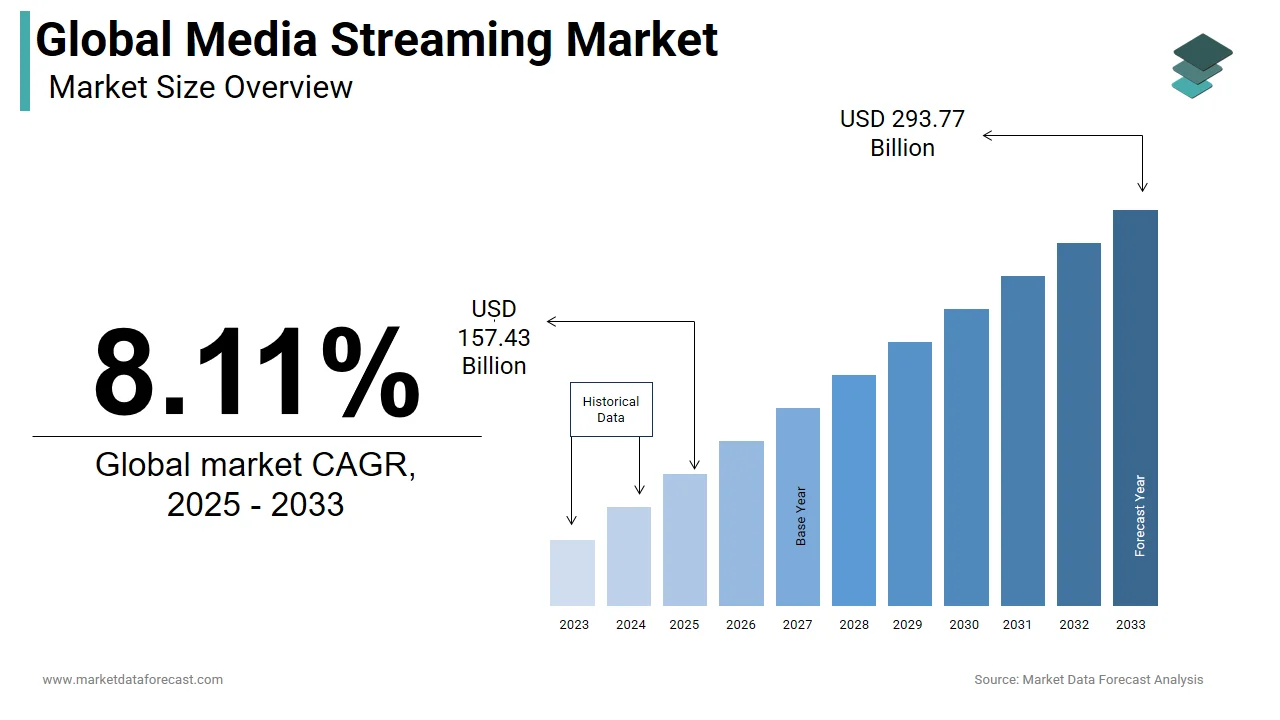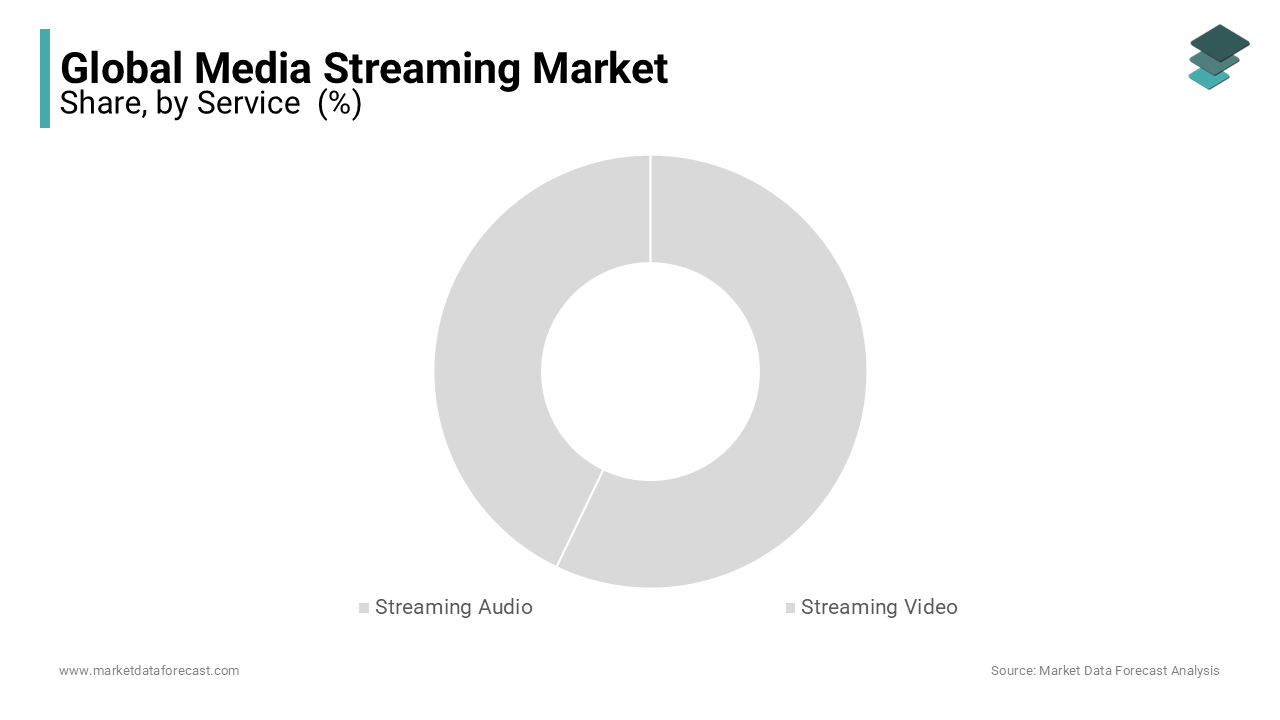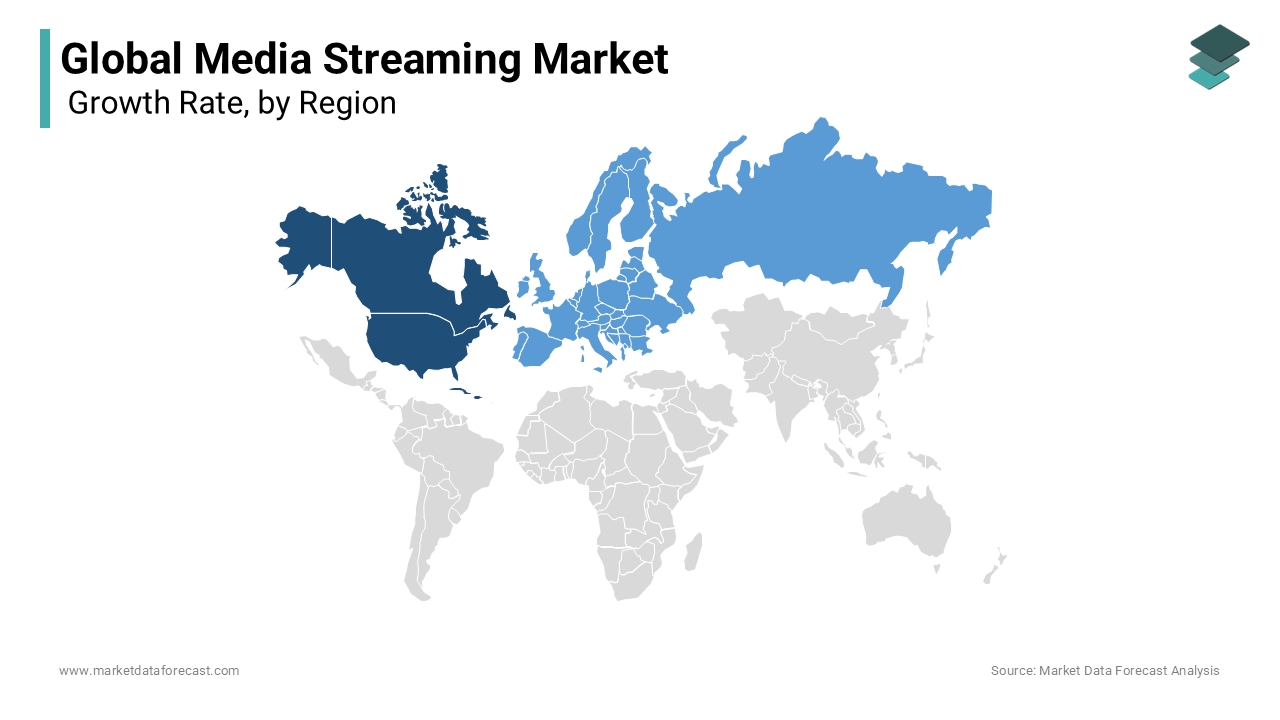Global Media Streaming Market Size, Share, Trends & Growth Forecast Report By Service Type (Audio Streaming, Video Streaming and Others), Application (Real-Time Entertainment, Web Browsing and Advertising, Games, Social Media and Online/Distance Learning), End-users (Personal/Household Users, Educational Institutions and Professional Organizations) and Region (North America, Europe, Asia-Pacific, Latin America, Middle East and Africa), Industry Analysis From 2025 To 2033.
Global Media Streaming Market Size
The global media streaming market was valued at USD 145.62 billion in 2024. The global market is expected to garner a CAGR of 8.11% from 2025 to 2033 and the global market size is predicted to grow from USD 157.43 billion in 2025 to USD 293.77 billion by 2033.

The media streaming market continues to grow, with viewers subscribing to more content providers and spending a longer time watching than ever before. Despite 87 percent of consumers streaming the same or more than the previous year, the total progress has decelerated with a decline of 4 percent against those watching more in comparison to 2023. This worldwide downturn is attributable to difficulties such as the effect of social media, churn, and competitive intensity.
On the other hand, the volume of self-paid streaming subscriptions for each subscriber has risen sharply. As per a study, presently, there is a 25 per cent surge in subscriptions per streamer. Also, consumer-paid subscriptions increased to 3.0 from 2.4 for each subscriber. This is influenced by platforms such as Disney+ and Netflix limiting password sharing.
Most recently, the Paris Olympics 2024 witnessed a dramatic surge in viewership in comparison with the Tokyo Games 2021, with striking social media engagement and online streaming numbers. Therefore, the market worldwide is quickly changing.
MARKET DRIVERS
The growth of the media streaming market is primarily driven by the rising demand for subscription services, the increasing availability of original and region-specific content, and the popularity of live sports.
These aspects are changing the strategies adopted by vendors in the market as the focus on improving customer experience through personalization and low-cost services is increasing day by day. The growing adoption of online video and audio streaming among domestic customers is propelling the global market growth. The rising adoption of high-speed Internet access and the increasing popularity of online television programs among the young population are creating opportunities that will increase the demand for the media streaming market during the forecast period. The market is likely to present opportunities for untapped markets and increased user awareness. The convenience of watching video content anytime, anywhere, the rise in mobile subscriptions and the adoption of connected mobile devices, especially smartphones, and the growing need for original content and live streaming are some of the main factors that are driving the growth of the global media streaming market.
The rapid usage of music streaming is expected to contribute significantly to the global media streaming market.
Music streaming providers offer exclusive content with podcasts and original content, which first attracts people to the platform and ultimately converts them into subscribers. In addition, promotional activities, such as price cuts for subscriptions in growing markets and bundles from telecom operators, are expected to further drive growth. For example, Spotify saw an annual growth of 31% in total revenue and a 35% share of total paid subscriptions, mainly due to the increase in promotional activities such as Spotify's free premium for three months, subscription model price cuts, etc. Market players are offering new features like curated playlists, night mode, and lossless music to improve targeting, which also gives businesses a competitive edge over others, thus increasing competition in the market. This is done to improve customer retention as the number of options in the market is continually increasing. For example, Amazon launched a new level of its music service, called Amazon Music HD. It offers lossless versions of audio files to stream or download at a comparatively lower price. Although global players are strongly penetrating their music streaming platforms by adopting various strategies, regional players still have a strong place in their respective regions, due to their exposure and a strong focus on local content. For example, Gaana is still the number one player in the Indian market, while Yandex Music is the leader in Russia. Also, Tencent Music Group is one of the main players in the Chinese market due to its applications.
MARKET RESTRAINTS
Transmission interruptions, piracy, and low bandwidth or limited transmission speed are some of the factors hampering the growth of the global media streaming market.
MARKET OPPORTUNITIES
The Asia Pacific presents a huge opportunity for the Media Streaming Market. The region is a young market, and access to the Internet has sharply risen, i.e., around 51 percent (which is still less than that of developed countries), due to extensive mobile phone usage and enhanced infrastructure. According to a survey, in Southeast Asia, the highest viewership rate is for traditional TV, but is closely followed by Ad-supported streaming services.
Moreover, in the coming years, as the market progresses is slated to see consolidation by a few dominant players as a result of higher acquisitions and mergers to transform the landscape of entertainment. With the availability of multiple streaming services, customers are witnessing what is called by industry experts “fragmentation fatigue”. Holding various subscriptions rapidly adds up, causing subscription fatigue. As consumers become progressively selective, the poor services struggle to keep their customer base, positioning consolidation as a reasonable measure to ensure survival.
MARKET CHALLENGES
The content moderation challenges impede the growth of the media streaming market. It is one of the most frequently encountered problems in video streaming platforms and companies. The quantity of content on platforms has increased significantly, which makes moderation work more difficult. Moreover, graphic or violent content is another challenge. The identification and elimination of such types of content are tough, as the percentage of people watching this is substantially high among the young generation, i.e., 70 percent. Additionally, the market changed substantially after COVID-19, with consumers giving more importance to what type of content to watch in their available time, so they have become more choosy on video streaming platforms. Therefore, derailing the market growth trajectory from its path.
REPORT COVERAGE
|
REPORT METRIC |
DETAILS |
|
Market Size Available |
2024 to 2033 |
|
Base Year |
2024 |
|
Forecast Period |
2025 to 2033 |
|
CAGR |
8.11% |
|
Segments Covered |
By Service, Application, End User, and Region |
|
Various Analyses Covered |
Global, Regional & Country Level Analysis, Segment-Level Analysis, DROC, PESTLE Analysis, Porter’s Five Forces Analysis, Competitive Landscape, Analyst Overview on Investment Opportunities |
|
Regions Covered |
North America, Europe, APAC, Latin America, Middle East & Africa |
|
Market Leaders Profiled |
Apple Inc., Adobe Systems Inc., Microsoft Corporation, RealNetworks Inc., Google Inc. (YouTube), Netflix Inc., Amazon.com, Inc., Pandora Media, Cía, Spotify AB, and Midwest Tape and Others. |
SEGMENTAL ANALYSIS
By Service Insights

Of these, the video streaming subsegment is expected to post the strongest growth. This growth is primarily attributed to the growing popularity of on-demand entertainment services, such as movies, shows, videos, and live games, on televisions and other portable device platforms.
By Application Insights
Today, the real-time entertainment applications segment dominates the global market for streaming media services. However, other application segments such as e-learning and web advertising are also emerging as potential revenue areas due to their increasing popularity among educational institutions and businesses. With cost reduction and the addition of innovative features, e-learning software goes beyond universities to include general business education.
By End User Insights
The adoption of video streaming services among home users is driven by the wide availability of high-speed Internet access and the increasing popularity of online television broadcasts among the young population in developed regions. Business organizations and educational institutions are also witnessing rapid adoption of multimedia streaming services and are expected to continue adopting these services during the forecast period.
REGIONAL ANALYSIS

North America continues to hold a commanding position in the media streaming market. It is expected to make significant strides in the coming years. The key propellant for the region’s market growth is the heightened consumption of online audio and video streaming content among domestic customers. A new study reveals that, on the whole, Americans are committing a significant 3 hours and nine minutes every day to streaming digital media. This involvement makes up more than 21 hours per week, which is on par with the dedication in a part-time job. Apart from this, the region’s market size has increased so much and keeps going up because of the presence of the key companies who have pioneered this and other supportive technologies, modern internet infrastructure and a massive active customer base with large online connectivity.
Europe holds a major market share inthe second spot and is projected to attain further growth during the forecast period. In the last two years, the region has experienced a considerable rise in the consumption of video subscription services. The regional market is propelling mainly due to the majority of households in Europe having a minimum of one subscription among various streaming platforms.
In other regional markets, emerging economies such as Brazil, China, India, and South Africa (BRICS) are experiencing high adoption of media streaming services. The growth of this market in these countries is mainly attributed to factors such as the introduction of high-speed data plans, the increase in online traffic (audio and video streaming), and pull-in program initiatives like online learning.
KEY MARKET PLAYERS
Some of the major players in the global media streaming services market include Apple Inc., Adobe Systems Inc., Microsoft Corporation, RealNetworks Inc., Google Inc. (YouTube), Netflix Inc., Amazon.com, Inc., Pandora Media, Cía, Spotify AB, and Midwest Tape.
RECENT MARKET HAPPENINGS
- In August 2024, Bharti Airtel reported the strategic collaboration with Apple, providing special offers for Apple Music and Apple TV+. According to the latest agreement, customers of Airtel Xstream are now eligible to access and enjoy the best of award-winning content and Hollywood on Apple TV+ added to Postpaid and premium Airtel Wifi plans. In addition, Apple Music will also be available to Airtel customers alongside Wynk Premium consumers, who will be presented with special offers for Apple Music from Airtel.
- In August 2024, Media Distillery and Zattoo entered into a partnership involving Machine Learning- and AI-enhanced Time Marker Suite, pre-certified for B2B managed platform service by Zattoo for operators Stream API. Further, Zattoo is all prepped up to introduce Stream API, which is a robust package of platform, tools, and services providing operators and application developers to quickly build, launch, and scale the next generation of streaming services and applications. Besides this, the objective of Zattoo is to establish an ecosystem of strategically produced and complementary B2B partner to further accelerate the rise of its managed service offering.
MARKET SEGMENTATION
This research report on the global media streaming services market has been segmented based on the type of services, applications, end users, and regions.
By Service
- Streaming Audio
- Streaming Video
- Others (Live Caption, Tape, And Real-Time Text)
By Application
- Real-Time Entertainment
- Web Browsing and Advertising
- Games
- Social Media
- Online/Distance Learning
By End User
- Personal/Household Users
- Educational Institutions
- Professional Organizations
By Region
- North America
- Europe
- Asia-Pacific
- Latin America
- Middle East and Africa
Frequently Asked Questions
Which regions contribute the most to the global media streaming market share?
North America, Europe, and Asia-Pacific are the leading contributors to the global media streaming market share, with significant adoption of streaming services and platforms.
What impact has the COVID-19 pandemic had on the global media streaming market?
The COVID-19 pandemic has accelerated the growth of the global media streaming market, with increased demand for home entertainment and a surge in subscriber numbers for various streaming platforms.
How are emerging markets contributing to the growth of the global media streaming market?
Emerging markets contribute to the growth of the global media streaming industry through increasing internet penetration, smartphone adoption, and a rising middle class with disposable income.
Who are key players in the global media streaming market?
Apple Inc., Adobe Systems Inc., Microsoft Corporation, RealNetworks Inc., Google Inc. (You Tube), Netflix Inc., Amazon.com, Inc., Pandora Media, Cía, Spotify AB and Midwest Tape are some of the major players in the global media streaming market.
Related Reports
Access the study in MULTIPLE FORMATS
Purchase options starting from $ 2500
Didn’t find what you’re looking for?
TALK TO OUR ANALYST TEAM
Need something within your budget?
NO WORRIES! WE GOT YOU COVERED!
Call us on: +1 888 702 9696 (U.S Toll Free)
Write to us: [email protected]